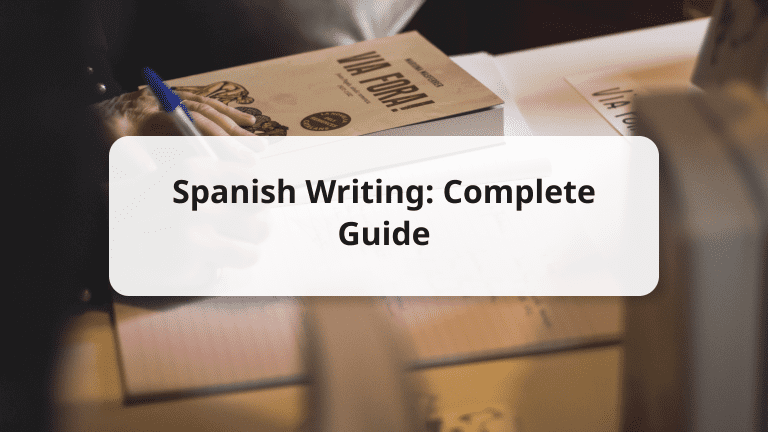Wanna work your way up to becoming the next Miguel de Cervantes in Spanish writing?
When learning Spanish or any language, you must master how to write in Spanish as it is one of the components that essentially make up a language. How else will you write Spanish e-mails, letters, or cheesy romance novels?
There is a lot to the skill of writing in Spanish — in this article we have created a step-by-step guide that will help you on your journey to learning to write in Spanish.
Table of Contents
How to Write in Spanish
1. Texting

Texting is an important Spanish writing skill, since you have to communicate with others! That’s why, texting in Spanish has its own set of rules.
- There is a handful of abbreviated versions of words or slang much like in English. They all follow a simple pattern, where vowels and consonants are commonly omitted. For example, the word porque meaning “why” would be spelled as “pq”.
- The letters Q and C become K. Take te quiero mucho for example, which means “I love you so much” will be abbreviated as tkm.
- Some abbreviations are specific and you would need to learn them. For example, bien meaning “good” will just be B in a text and no te preocupes meant “don’t worry about it” will be just a ntp.
- Just like in English, you can use numbers to signify a word, such as 1thing (one thing). A Spanish example of this would be salu2, the abbreviated form of saludos meaning “regards”.
- Acronyms are usually the same as their English counterparts, but you do find some cases where it is different. Take WHO (World Health Organization), this would be known as OMS (Organización Mundial de la Salud).
Remember: Abbreviated or slang words in text should only be used when speaking to family and friends. Write out the entire sentence when being formal!
2. Writing a letter

Before writing a letter, you must decide whether it will be formal or informal— since there are a lot of different rules between the two.
- Before you start with the body of the letter, you must first greet the person which is usually in the form of “Dear Mr. So and so”. When greeting someone in a Spanish letter, the word Querido/a meaning “dear” is used and when writing a formal letter, the word Estimado/a is used, which also means “dear” but just in a more formal tone.
- With the informal greeting phrase, you may only use the recipient’s name, such as Querido Pedro. With a formal letter, you would need to add a title which can be Señor/Sr. (Mr.), Señora/Sra. (Mrs.) or Señorita/Srta (Miss). The title is followed by the recipient’s surname such as Estimado Sr. Lopez.
- In the body of an informal letter, when writing “you” (as in speaking about the recipient) you should write it as tú and in a formal letter, you use usted (singular)/ ustedes (plural) instead.
- When closing off the informal letter, you can use Besos y abrazos which means hug and kisses. In formal letters, you would rather use Saludos meaning “regards” or Cordialmente/Atentamente which means “Yours sincerely”.
An informal letter would then look something like this:
Querida Amelia:
(Dear Amelia):
Gracias por ayudarme el otro día ¡Te aprecio! Eres una buena amiga.
(Thank you for helping me the other day. I appreciate you! You are a good friend)
Besos y abrazos,
(hugs and kisses)
Pedro Gonzales
A formal letter would look like this:
Estimado Sr. Lopez:
(Dear Mr. Lopez):
Me gustaría programar una reunión de equipo para mañana ¿Estaría bien con usted?
(I would like to schedule a team meeting for tomorrow. Is that fine with you?)
Cordialmente, (Cordially)
Pedro Gonzales
3. Writing an Email

Knowing how to write an email is especially important in a professional setting, make sure you know how to! The tone of the email depends on the opening and closing statement, and the overall vocabulary used. The rules for informal and formal emails are the same as the rules for writing in Spanish letters. In a formal email, you may also open with A quien corresponda meaning “to whom it may concern” if you are not sure to who you are writing.
Email structure follows this pattern: greeting, the reason for writing, the body of the email, and a closing statement.
When giving your opinion on a subject, use phrases such as:
- en mi opinión…, (“in my opinion..”)
- creo que…, (“I believe that..”)
- me parece que…, (“it seems to me that..”)
When agreeing or disagreeing with a statement, add phrases such as:
- estoy de acuerdo…, (“I agree..”)
- no estoy de acuerdo… (“I disagree..”)
- es falso que…(“it is false that..”)
An informal email would look like this:
Querido Luca:
(Dear Luca):
Creo que Mary ya ha enviado las invitaciones. Asegúrate con ella.
(I believe that Mary had already sent out invitations. Make sure with her.)
Un cordial saludo,
(Warm regards,)
Pedro Gonzales
A formal email:
Estimado Sr. Lopez:
(Dear Mr. Lopez):
No estoy de acuerdo con que debemos pasar a la siguiente etapa. En mi opinión, necesitamos más personal antes de hacer esto.
(I disagree that we should move to the next phase. In my opinion, need more staff before we do this)
Saludos,
(Regards)
Pedro Gonzales
4. Journaling in Spanish

Journaling is when you write down your everyday thoughts and emotions. Considering this is a safe space to write your everyday experiences— there aren’t any rules. Whether you want to write grammatically correct Spanish sentences or absolute nonsense, this choice is up to you. People generally use journaling to make sense of their emotions or overcome anxiety. You can write down what you are thankful for, your hopes, your fears, what motivates you and your goals, whatever you want to.
Some useful phrases:
- Estoy agradecida/agradecido por… (I am thankful for)
- Mis esperanzas… (my hopes)
- Hoy me senti… (today I felt..)
- Estoy motivada/motivado por… (I am motivated by..)
- En el futuro me gustaría… (In the future I would like to..).
For example:
Hoy me sentí triste porque mi hermano se va. Estoy seguro de que aprovechará al máximo esta oportunidad… pero aún así 🙁 Ojalá supiera cómo decirle adecuadamente cuanto lo extraño en español.
(Today I felt sad that my brother is going away. I am positive that he will make the most of this opportunity.. but still 🙁 I wish I knew how to properly say I miss you in Spanish.)
5. Notes

Notes can be very useful, you can use them to remind yourself or someone else of something, to say thank you, ask someone for a favor, and more! Notes are generally quite short and only contain about two to three words since you should generally outline the point of your note.
Some phrases that notes may contain can be:
- te amo (I love you or any form of “I love you” in Spanish)
- recuerda: toma tus medicamentos (remember: drink medication)
- ¿café? 🙂 (coffee? 🙂 how cheeky!)
- ¡Gracias! (Thanks!)
Important Spanish Writing Rules

Just like English, Spanish has rules when it comes to writing. These rules are essential!
Spelling in Spanish
So, you need to know how to spell Spanish words in order to get the message across to your recipient. I don’t think anyone would understand a bunch of randomly/wrongly placed letters!
Each letter in the Spanish alphabet (which is the same as English) always corresponds to a certain sound. There are some exceptions, however.
Letter “H”:
The letter H is always silent but is still important when spelling a word, as its presence and/or absence can change the meaning of the word— such as when ola (wave) gets an H and is converted to hola (Hello). As an example, the word hermana (sister) is pronounced as er-mah-nah; the H is not pronounced. The sound of the letter C is changed when placed before an H, the word chacal (jackal) is pronounced as cha(as in chap)-cul.
Paired Letters:
There are some paired letters in Spanish that can confuse any inspiring Spanish writer. Since there are too many words to learn that contain these couples, it’s best to turn to the dictionary for help! These pairs are; b/v, r/rr, g/j, ll/y, c/k/q and c/s/z.
Accents:
There will be accent marks on most words. These marks will tell you how a letter is pronounced and can even change the meaning of the word! Accent marks are very important when it comes to Spanish writing.
For example, in the word tráfico which means “traffic”, when removing the accent mark on the a, it forms tráfico meaning “I smuggled” and if you place an accent mark on the o it forms traficó which changes the word to “he smuggled”.
Capitalization Rules in Spanish
It’s pretty straightforward to understand capitalization in Spanish. Unlike English, unless this word is the first in a sentence, the following is not capitalized;
- Personal titles,
- Months
- Days of the week
- Languages
- Religions
- Yo (I)
- Nationalities
- Movie titles. If not the first word in a sentence, only the first word in the title is capitalized.
- Movements or organizations, social and political.
- Book titles. If not the first word in a sentence, only the first word in the title is capitalized.
Punctuation Rules in Spanish
Spanish and English have a lot of common ground when it comes to punctuation. There are a few new rules found in Spanish however:
- Commas, periods, and other punctuation marks are placed outside quotation marks. Such as in English it would be “my heart.” but in Spanish, it would be “mi corazón”.
- There are no oxford commas. The last two items in a list will be joined by a conjunction like and (y) or (o).
- The first word after a colon is not capitalized.
- There are opening questions and exclamation marks (¿ and ¡).
- A dash is used in dialogues instead of quotation marks, instead of “I’m here,” The man said, it is -Estoy aquí- dijo el hombre.
- When writing down numbers, it’s the opposite of how you would in English. You use a period to separate groups of thousands, instead of 1,589 or simply 1589, it will be 1.589. Commas are then used to separate decimals $1,50 will be one dollar and 50 cents instead of $1.50.
- Instead of using a comma after greeting someone in an email or letter, a colon will be used. Instead of Estimado Sr. Lopez, it will be Estimado Sr. Lopez:

How to Improve your Spanish Writing
Now that you know the basic steps to start your Spanish writing journey, here are 5 tips to help you progress quicker.
1. Brainstorm

In order to write something, you must learn how to form ideas on WHAT you want to write. Brainstorming is great for beginners, although, even master authors still use brainstorming to come up with new ideas. Start off by thinking of a general concept that you will be writing about, then slowly build on that concept. Question everything about that concept, and write it all down in Spanish (some nice extra practice). When you have finalized everything and hatched a complete plan, write it! Create your masterpiece no matter how small or simple; just do it!
2. Read, read, and read in Spanish!
The more you read, the better your writing will get! Integrate reading in Spanish into your everyday routine. Even if you just read a small section in a Spanish newspaper— anything goes! That being said you can read anything that grabs your interest as long as it is in Spanish, it’s a good idea to switch it up now and then to a new topic in order to broaden your Spanish vocabulary.
As you start reading in Spanish, start with simple books or small passages in a newspaper. Children’s books, familiar ones such as La Cenicienta (Cinderella) is a great way to start reading. For more intermediate reading, books such as El Príncipe de la Niebla (The Prince of Mist) by Carlos Ruiz Zafón will help improve your reading even more. Finally, as you get to the more advanced stage of reading, difficult books such as La Vida es Sueño (Life is a Dream) by Pedro Calderón de la Barca, a Spanish classic, will take your reading abilities to new heights!
3. Try Writing Often
Consistency is key. Try to write something in Spanish every day. From writing your grocery list to writing in your journal, no matter how small, you just need to write something and there are many formats of writing to choose from (as seen previously). It’s amazing to see how much we actually write in our daily life, just switch it up to Spanish. Try to write for the sake of writing and not to impress someone, less stress means you will be more willing to write something.
4. Learn Linking Verbs
These are words that link or show the relationship that paragraphs have with each other. It will help your sentences flow better and help you build your writing style!
There are a lot of linking verbs to choose from, we will highlight the ones you would probably use more often.
To add more information or give more context to an idea, you can use:
- Además (similar to moreover, and, furthermore, and in addition)
- También (similar to too, as well, and also)
To contrast an idea, you can use words like:
- Pero (but)
- Sin embargo (however)
- No obstante (nevertheless).
To give an example, you would use:
- Por ejemplo, (which means just that)
5. Ask for Peer Feedback

Getting someone who is advanced in Spanish reading, a native, or a Spanish tutor to review your Spanish writing is important. In this way, you will know where your problem areas lie and what you should work on but also what you excel at. Going in blindly will result in you improving at an incredibly slow pace. Besides, this person helping you can also give you some handy tips and trips to reach your Spanish writing goals faster!
6. Prepare for a Spanish Writing Test
Whether you are learning Spanish for fun or for educational purposes like to receive a Spanish certification, preparing for a Spanish writing test is always a great idea! One way to prepare for a Spanish writing test, is by finding different essay topics online and start writing about them! Once you’ve got that part down, you’re on your way to significantly improving your Spanish by being able to go back and correct any mistakes you caught.
Haciendo y Deshaciendo Se Va Aprendiendo! (It’s By Doing and Undoing That We Learn)
Writing in Spanish can seem a bit tricky, but as you ease yourself into it you’ll notice that it isn’t all that bad! There are many styles of writing, and one of them is bound to suit your fancy. Just keep the grammatical rules in mind as you write, and it will also be in your best interest to first learn how to actually learn Spanish.
AmazingTalker has a wide range of language tutors that will help you reach your fluency/writing goals in no time! All of this and more, at AmazingTalker!
















